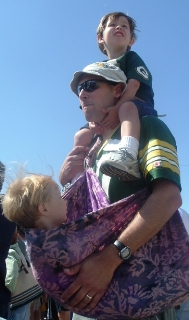Stay-at-home dad
The examples and perspective in this article may not represent a worldwide view of the subject. |
A stay-at-home dad is a term used sometimes for a male parent who is the primary caregiver of his children and home. To a lesser extent stay at home father, househusband or homemaker are also used. In North America "Mr. Mom" is a rarely used facetious term connoting a disparaging attitude. The term "stay-at-home" is also sometimes considered disparaging. The neologism "househusband" is sometimes avoided because it is a tautology (the word "house" is derived from the same Germanic element as the first part of the word "husband").
A new term coming into favor with increasing numbers of men is 'XO' (Executive Officer), also known as 'The Exec', or 'Exec', due to parallels which can be made between the responsibilities of homemaking and analogous paid duties in a military unit (cleaning = janitor, cooking = mess, laundry = quartermaster, shopping = supply officer, budgeting = logistics, minor discipline = unit discipline). [citation needed]
The number of single dads has increased in recent years. It appears that the men are now fighting to take care of the kid instead of the mother. The father tends to have more guidelines with their kids.[citation needed]. The number of same sex households with kids is also increasing, where one of the gay fathers go to work and the other is the homemaker.
In homes with a mother and a father, these duties were traditionally done by the mother; this still holds in most families with a mother and father present. "Stay-at-home dads" (SAHD) or "at home dads" (AHD) usually have many household responsibilities that go along with day-to-day care of their children.
As recently as 25 years ago, such an arrangement where the father would be home was almost unknown in Western countries (with the exception of certain farm arrangements in the Canadian Prairie Provinces). In recent years, "stay-at-home dads" are becoming more common and accepted.
In many families in industrialised nations, the contact a father has with his child has been quite considerably reduced since the industrial revolution,[1] since children in industrialised countries have become far more focused on extended periods of learning outside of the home. In developing areas of the world, male members of the family still have considerable roles in child rearing, and grandfathers, uncles, and cousins in extended families have provided such support for generations.[citation needed]
The arrangement has been socially accepted in much of rural Canada since the 1930s, however. It started there when fathers stayed on the farms and worked there while their wives worked in the towns.

Mother's role in household
In families with a stay-at-home dad who has a mother present, the mother usually has a full-time job and makes most of the income for her family. The "swapping" of roles works well for many families. The mother may have a professional occupation that requires substantial time at the office in exchange for the salary to support the family on one income. Household tasks may be shared more than "traditional" Western roles might prescribe.
In these arrangements, the father will assume the majority of the household chores (cooking, cleaning, and laundry) and childrearing. However when the mother gets home from work, the mother will often reassume these duties from the "stay-at-home dad" (see also double burden). This is something that is more common than in families involving a traditional "stay at home mom".
Stay-at-home dads in the United States
More than 100 dads annually attend a national At-Home Dad conference. This multi-day conference includes parenting classes, large and small group discussions about the importance of fathers, and social events. Oakton Community College in Des Plaines, Illinois hosted the conference from 1995-2005. The Universty of Missouri Kansas City Women's Center has hosted the conference since 2006. The next conference will be in Kansas City on November 3 , 2007. www.athomedadconvention.com
Mr. Mom movie
The Michael Keaton movie Mr. Mom (1983) features one of the more famous portrayals of a stay-at-home dad. Many stay-at-home dads dislike being labeled Mr. Mom because of bumbling aspect of the father in the movie and the feeling that stay-at-home dads are trying to be a mother. Many feel that their contribution is as a father and that is just as important to children, but distinct from a mother's contribution.
A 2004 country rock song entitled "Mr. Mom" was released by the Lonestar duo.
Groups
In many parts of the U.S., "stay at home dads" have dads' playgroups available. These groups allow their children to do activities with children of other "stay-at-home dads". These groups help support the dads and encourage interaction with their children. Existing playgroups had already been created to benefit "stay-at-home moms" and their children. Many of these groups readily accept dads. There are national and local stay-at-home dad groups and e-mail lists.
"Stay-at-home dads" (SAHD) collectively have been jocularly referred to as "the SAHDness", just as "Stay-at-home moms" (SAHM) collectively may be jocularly referred to as "SAHM Hill". Terms such as these are not widespread, and are used mostly in weblogs.
References
- ^ Palmer, Gabrielle 1993. The Politics of Breastfeeding
